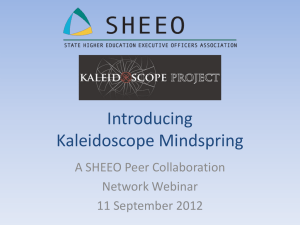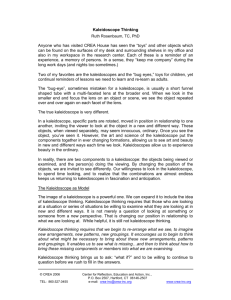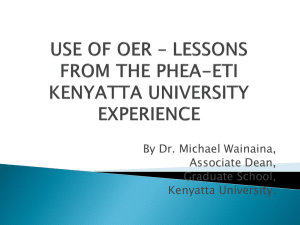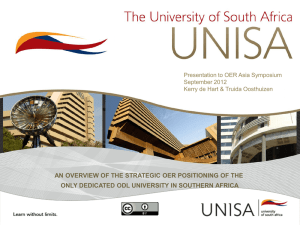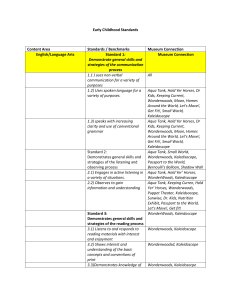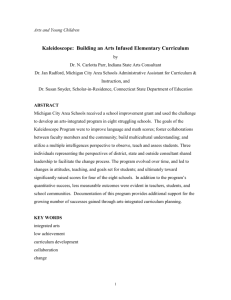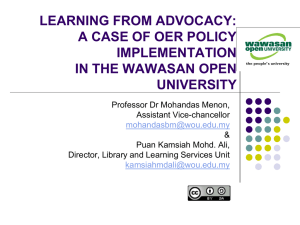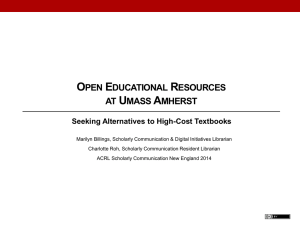Welcome to the OER Summit (PPT)
advertisement
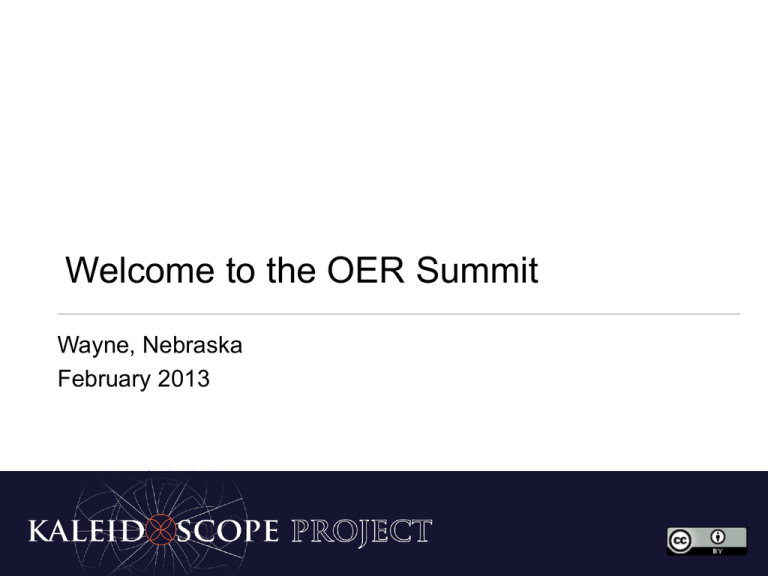
Welcome to the OER Summit Wayne, Nebraska February 2013 Education budgets Rapid scale Economics of disruption Rapid scale Economics of disruption Education budgets Moody’s Investors Services downgraded the outlook for all of higher education to “negative.” 1. Tuition revenue 2. State appropriations 3. Federal spending 4. Endowments 5. Philanthropy Education budgets 1. Tuition revenue 2. State appropriations 3. Federal spending 4. Endowments 5. Philanthropy Education budgets Federal appropriations per FTE are at their lowest point in 40 years. SOURCE: The College Board, Trends in College Pricing 2011, Figure 10B. Education budgets Economics of disruption Rapid scale Time to Reach 150 Million Users 1994-1998 The Internet 4 2004-2009 Facebook 5 2001-2008 iPod 7 1983-1997 Cell Phone 14 1928-1966 Television 38 1876-1965 Telephone 89 0 20 40 60 80 100 With 2.4 billion accessing the Internet • LinkedIn has 220 users sharing professional profiles and networks • Twitter has 500 million users, and sends 175 million tweets each day • Facebook has more than 1 billion active users. 618 million on Facebook daily. Education budgets Rapid scale Economics of disruption Can we create a deliberate, planned and effective approach to disruption? The Kaleidoscope Context 1. Content as infrastructure 2. Innovation capacity as infrastructure 3. Discerning scale 4. Discerning disruption The Kaleidoscope Context 1. Content as infrastructure 2. Innovation capacity as infrastructure 3. Discerning scale 4. Discerning disruption The Kaleidoscope Context 1. Content as infrastructure 2. Innovation capacity as infrastructure • Licenses for sharing (Creative 3. Discerning scale Commons) 4. Discerning disruption • Processes for sharing • Relationships for sharing • Investment models for sharing • Institutional support for Kaleidoscope Open Course Initiative Charles Snare, VP Academic Affairs, Chadron State College Amber Gilewski, Assist. Professor Psychology, Tompkins Cortland CC Before $2B in Department of Labor grants… Before the California open textbook bill… Before the British Columbia open bill… Private foundations had invested well over $100 million in open content Hewlett. Gates. Saylor. Lumina. Shuttleworth. CK12. Kresge. Spencer. Walter S Johnson. Moore. Open Educational Resources Freedom to reuse, revise, remix and redistribute Project Goals Use open educational resources to improve student success 1. Eliminate textbook cost as a barrier 2. Drive assessment-driven enhancement of course designs and materials 3. Create a collaborative community to share learning and investment Why Kaleidoscope? Collaboration #1 – Valuing teaching • “We must change the status of teaching from private to community property” – Lee Shulman • Shulman argues the reason teaching is not more valued is “because the way we treat teaching removes it from the community of scholars” Collaboration #2 Minimize loss of intellectual work on teaching and learning “To me the most important benefit of creating a community [around teaching and learning] is that we no longer lose a great deal of intellectual work that is regularly being done. Talented people find ingenious solutions to problems in learning every academic term, and traditionally most of that work is lost. When people know that there is a community of people who will look at their work, especially the cumulative intellectual work of several offerings of a course, they will be willing to take the modest extra steps of recording and reflecting on what they are already accomplishing as teachers. As a result there will be a large community of teachers whose decisions about how to teach will be informed by the collective effectiveness of the work.” D. J. Bernstein Collaboration #3 Moving from the “deficit model” of teaching (Randall) to the creative problem approach “One telling measure of how differently teaching is regarding from traditional scholarship or research within the academy is what a difference it makes to have a ‘problem’ in one versus the other. In scholarship and research, having a ‘problem’ is at the heart of the investigative process; it is the compound of the generative questions around which all creative and productive activity revolves. But in one’s teaching a ‘problem’ is something you don’t want to have, and if you have one, you probably want to fix it. Asking a colleague about a problem in his or her research is an invitation; asking about a problem in one’s teaching would probably seem like an accusation.” Randy Bass Collaboration #4 Post-Moneyball approach • Heuristics applied by computers and humans • Computers and humans employ different heuristics • Each produce biases and blind spots Implications for student learning (engagement; retention; graduation) • Identify “moments of difficulty” – inability to understand (Salvatori) • Blockage points in courses and programs (Tinto) • Predictive analytics Advise students Early alert – students not succeeding Cost Savings? • Don’t worry about the scoreboard (Wooden) • May come in other ways Higher retention and graduation rates – cost per degree attainment measure Currently treat all activities as having an equal impact on student learning – everything is high impact Better understand when student “choice” is a choice Move away from the “add a course strategy” (Parker Palmer) to a plan of connected learning (AAC&U) CSC Institutional Experience • Student learning does not occur by chance (Tinto) Transitional thru Composition sequence • Faculty professional development and network within program/discipline/colleges • Teaching as a community property Focus on area of expertise in course development Areas of student learning difficulty points; sequencing • Textbook/course materials cost savings • The Six Phases of a Project • What Got You Here Won’t Get You There Using OER with the Kaleidoscope Project Amber Gilewski Assistant Professor of Psychology Tompkins Cortland Community College Dryden, New York Impetus for the Kaleidoscope Project • 70% of undergrads report not buying one or more textbooks due to cost • 78% believe they would do worse if they didn’t have their own copy of the textbook to use • Cost of textbooks is equal to 26% of tuition at state universities & 72% of tuition at community colleges (GAO, 2005) • Major concern for community colleges who have lower graduation & retention rates Source: Student Public Interest Research Groups (PIRGS) OER in Action: the Kaleidoscope Project • Kaleidoscope was a cross-institutional collaboration • Course designs used the best of existing OER • Course designs used a common assessment process • Project Kaleidoscope closed the loop on improved course design & student learning Course Design Process 1. 2. 3. 4. 5. 6. 7. Define collective student learning outcomes Create summative assessments Identify core open resources Create formative assessments Identify supplemental open resources Deliver courses Evaluate and improve The Kaleidoscope Project Goals • Cost Effectiveness Outcomes Metric: textbook cost/course/student Goal: $50 average reduction • Student Success Outcomes Metric: academically-driven withdrawals Goal: 5% reduction Metric: grades of C or higher Goal: 5% increase Results in the Kaleidoscope Project BEFORE/USING Withdrawals % passed % of Ws BEFORE OER # with C or better 90/178 15/193 50.56% 7.8% USING OER 69/127 8/135 54.33% 5.9% -Compared 6 sections of Intro to Psych classes taught in Fall 2010 & Spring 2011 before using OER to 5 sections of Intro to Psych classes taught in Fall 2011 & Spring 2012 -Used open textbook written by Charles Stangor from Flatworld Knowledge, rSmart Sakai learning management system, and webenhanced courses -Students could read book online for free, could buy a hard copy that was almost 50% cheaper than typical book, or other formats Results in the Kaleidoscope Project • 7.4% increase in those passing my Intro to Psych classes with a C or better while using OER • 24% decrease in withdrawals while using OER • 32% reported using the free online version of the text, 58% used the hard copy, and 11% used other formats 90 80 70 60 50 40 30 20 10 0 Historical Success Kaleidoscope Success in OER Use • OER are resources that can be used for free or at lower cost • Choose OER carefully and remember you can often edit them • Using OER can create more accessibility and affordability for students Carnegie Mellon CC-OLI (Community College Open Learning Initiative) • Pilot evaluation of effectiveness of online courses used with F2F classrooms • For use in Statistics, Anatomy & Physiology, Biology, and Psychology courses (see http://oli.cmu.edu if interested in participating) • Intro to Psych class is based on the Flatworld Knowledge text used in Kaleidoscope • Online activities that accompany the reading and allow students to practice what they are learning before getting to Checkpoints (quizzes) My experience thus far…. Benefits Challenges • • • • • Learning curve for learning new systems • Initially time consuming for new developers • Experimental • Collaboration • Getting buy-in from other faculty Exciting Innovative Advised by experts in OER Free or low cost educational resources • Increasing student success & retention • Collaboration Opportunities to Engage Kim Thanos Kaleidoscope Program Manager Faculty Members Adopt an existing course, emphasize support and ease of use Use your own OER Use Kaleidoscope as a starting point and customize your course, with little collaboration Actively engage in the project and community Institutional Leadership Monitor project leadership and support local work Use Kaleidoscope as a starting point for institutional open strategy Identify areas for shared investment and deep collaboration System Leadership Monitor project leadership support colleges Lead a regional initiative Strategically create an open niche for Nebraska and the system Bridging programs with high schools Systematic support for adoption Textbook Zero programs Engage in policy efforts to facilitate and fund open education
